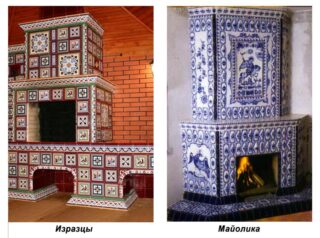A brick heating stove does not always fit into the interior. To give it a more decorative or style-appropriate look, it is faced with ceramic tiles. They choose a special material for this: heat-resistant, with low water absorption and high strength.
Is it possible to overlay the stove with tiles
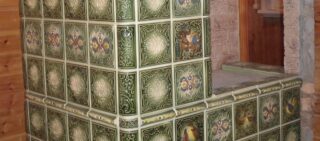
Tile is a type of ceramic tile. Traditionally, this is the name for fairly large products with a smooth surface, one-color or with a pattern. However, this definition is purely consumer in nature. Majolica, glazed cotto and other types of ceramics usually have a smooth surface. Since the choice of finishes has become much larger, today any facing tile, with the exception of porcelain stoneware, is called a tile.
It is possible to cover the stove with tiles in a private house if it meets the following requirements:
- Heat Resistance - the oven heats up quite a bit and the finish must be able to withstand the heat. In the marking of a suitable product there is a letter "T" and a number indicating the number of firing - 2 or 3.
- The coefficient of thermal expansion should be as close as possible to a red clay brick. Usually it is 7-8%.
- Low water absorption - the package must have the letter "E", and the water absorption index is not more than 3%.
- The production technology is preferable to the option obtained by the extrusion method.
The wear resistance of the tile does not really matter, since it is reveted with a vertical surface.
Types of tiles
- Classic tiles for a brick oven - tiles. A type of terracotta glazed ceramics with a specific shape. The front surface is smooth - patterned, with an image, the inner surface - with a rump and a rim. This structure significantly increases thermal conductivity. The tiles look extremely attractive.
- Majolica is a fairly porous ceramic. However, on the front side, it is covered with a smooth colored glaze, which protects it from water. Fireplaces in the living room are sheathed with majolica.
- Terracotta is a tile obtained by firing high quality kaolin clay. Very durable, lightweight, conducts heat well. The color scheme of terracotta retains all the richness of natural shades. They decorate rustic-style stoves with it.
- Clinker - made from refractory shale clay. Extremely durable and heat-resistant, does not absorb moisture, does not crack. In appearance, it often resembles a brick.
- Porcelain stoneware - the material is often lined with a fireplace. A genus of artificial stone, characterized by very high strength and very low porosity. Imitates granite, marble, basalt and other natural materials.
Tiles or majolica are decorated in a very different style: under Gzhel, under a brick, under a stone, under a mirror.
Cladding methods
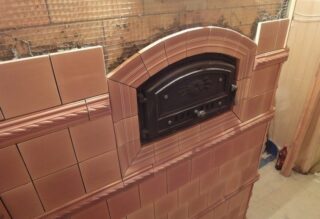
Decorating the stove with tiles and ceramic tiles is done in 2 ways.
- For glue - special heat-resistant glue is used for fastening, since ordinary heat cannot withstand such heating. The tile is simply pressed against the wall and held for a few seconds. The main difficulty is to correctly and beautifully lay the cladding.
- No glue - L-shaped metal corners are made for each tile. A strapping is made from the corners to the surface, and then the finish is attached to the corners.
Tiles are also attached without glue. On the inside of each tile there are wire grooves.The latter is embedded in the masonry, and then a tile is put on it.
The choice of adhesive
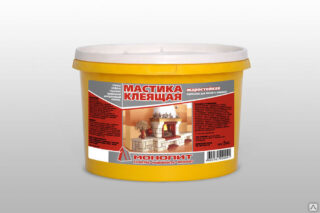
To correctly lay ceramic tiles on the stove, you need to choose the appropriate composition. Most often it is a clay mortar, similar to masonry. It's easy enough to work with him.
Other formulations can also be used.
- Cement-clay mixtures. Standard ratio of components: 1 proportion of cement, 1 clay, 1 chalk and 3 sand. Knead dry, and then dilute with water to the desired consistency. Liquid glass is also added to the composition when it is necessary to work with large-format tiles or panels.
- Fireclay mixtures are based on fireclay kaolin clay, cement and synthetic ingredients. They are distinguished by very high heat resistance. Such mixtures are used to decorate fireplaces.
- Refractory adhesives and mastics are ready-made mixtures specially designed for facing fireplaces and stoves. The marking indicates the temperature that the composition can withstand. For finishing, only mastics with an indicator of more than + 200 ° C are used.
Ready-made mixtures almost always include chamotte clay. But thanks to plasticizers and other artificial additives, such glue is put in a thinner layer, it adheres better and provides a stronger fixation.
Furnace measurement and tile calculation
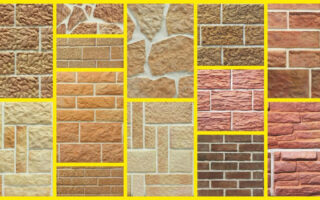
To calculate how much material is needed, you need to determine how it fits:
- in a straight line - parallel to the floor;
- diagonally - rhombus;
- staggered - changing colors, and sometimes sizes;
- pattern - tiles of different sizes and configurations alternate here.
The calculation in the first case is very simple: the area of all surfaces is calculated and divided by the area of the selected tile. They are rounded up: the tiles will have to be cut during installation. It is advised to increase the volume by 15%, taking into account the possible fight and mistakes.
With a diagonal laying, they take a larger margin, since here you will have to cut much more. With a complex stacking scheme, special methods are used for calculations.
You can calculate the amount of material using a special online calculator.
Substrate preparation and tiling
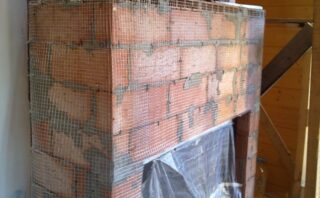
The preparation includes several stages. The old stove, tiled with tiles, is freed from the decoration, the remaining glue is removed until the base is completely cleaned. The seams between the bricks are deepened by 5 mm. It is recommended to align the wall: fix a mounting mesh with a mesh size of 5 cm to the surface.
The walls of the new stove in the country are simply cleaned of debris and remnants of masonry mortar.
- The walls are primed. The composition reduces glue consumption and improves adhesion.
- It is recommended, especially with little experience, to mark each surface with a level. If staggered or more complex masonry is planned, it is better to first lay out the tiles on the floor, determine the order and mark the back side.
- Begin laying with the installation of a corner element. If there is already a floor in this room, a support rail is previously attached to the perimeter of the case.
- A layer of glue is applied to the surface of the tile with a notched trowel. Layer thickness - 2–7 mm. Press against the wall for 10-30 s. You can correct the position for another 10 minutes.
- The next tile is laid with a gap. So that the seam is the same everywhere, mounting crosses are placed between the tiles.
- First, whole elements are laid in a row, then cut. A tile cutter is used for cutting.
- Finish the grouting of the tile joints. With a rubber spatula, apply a composition - contrasting, matching in color, and remove the excess with a damp sponge. Carry out the last cleaning after the grout dries - after 1–2 hours.
The oven is cleaned after facing no earlier than 3-4 weeks later.
Care and maintenance
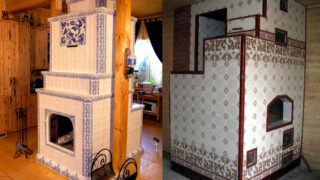
It is not difficult to take care of the finish.
- Dry cleaning is performed as needed. Cleaning time does not matter.Use a soft cloth or vacuum cleaner for cleaning.
- Wet cleaning is carried out with heavy dirt. In this case, the surface of the stove must be completely cooled.
- For wet cleaning, use warm water and soap.
- Tiles with a glazed surface are washed with slightly alkaline agents to give the surface a shine.
Tiling the stove is a very good solution. Ceramics perfectly conducts heat, withstands heat, does not crack or deform. The material is very beautiful and varied.

